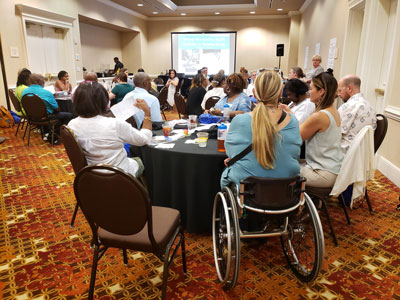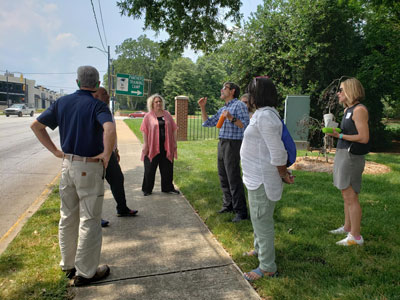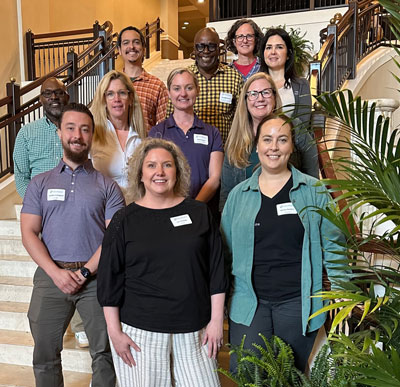
South Carolina’s picturesque landscapes, historic charm, and vibrant communities have long attracted residents and visitors alike. However, beneath the surface of this Southern gem lies a set of walkability challenges that impact both rural and urban areas.
Five cross-disciplinary teams representing rural communities in South Carolina were recruited to address walkability and movability with the help of national and state experts. The two-day National Association of Chronic Disease Directors (NACDD) Walkability Action Institute course focused on community and transportation design. Teams entered the training with the commitment to create action plans, participate in multiple virtual follow-up classes and implement action plans without any dedicated national or state funding for the time being.
“With NACDD guidance, the teams were intentionally made up of public health, planning, transportation, elected officials and other community members to help them understand that it takes more than just one department to successfully implement changes,” said Meg Stanley, executive director at Wholespire. “Cross-disciplinary teams also gain a greater understanding of how to leverage their resources to create a more liveable, sustainable and inclusive environment.”
Participants representing Anderson, Fairfield, Georgetown and Williamsburg counties and the cities of West Columbia and Cayce got hands-on training after their lectures and small group discussions. They performed a walkability assessment in downtown Spartanburg and found out that even the best laid out plans may not be the best. During the assessment, they discovered that when crossing roads, a vision-impaired individual is led into traffic and not toward the crosswalk because the crosswalk ramps with bumps or ridges are not always placed in the correct direction. Another learning point that was observed is that the sidewalks are wide enough for a person in a wheelchair and another individual to move comfortably side-by-side.

“As people who use cars for transportation, many of us take for granted the ease of access to parks, school, the office, the grocery store and many other places we visit. When we are planning projects, we must stop and think about those of us who may only depend on wheelchairs, bicycles, walking or other modes of transportation. An even smarter thing to do is have a conversation with those people and ask about barriers to getting from point A to point B,” said Stanley.
Walkability refers to the measure of how friendly an area or neighborhood is for walking. It takes into account various factors that influence the ease and safety of walking as a mode of transportation and a way to access amenities, services, and recreational areas. Walkable communities are designed to promote pedestrian activity, reduce dependence on cars, and enhance overall quality of life.

First Row (l-r): Landon Campbell (SCDHEC), Lori Phillips (SCDHEC), Kelsey Sanders (Wholespire)
Second Row (l-r): Torri Toland (SCDHEC), Meg Stanley (Wholespire), Kaylin Garst (YMCA), Sara Griffin (Clemson University)
Third Row (l-r): Guillermo Espinosa (SCDOT), Ken Harvin (SCACED), Amy Ely Johnson (Palmetto Cycling Coalition), Paola Gutierrez (SCORH)
The five community teams meet virtually on a recurring basis to learn from national experts about topics related to movability and to seek guidance from the state team and each other on action planning, potential new team member recruitment, and project implementation. All five teams have developed action plans as described below.
The Georgetown County team wants to improve safe access to all schools in the Town of Andrews and add a bike lane shoulder along Plantersville Scenic Highway. They’re working to establish a partnership with Safe Routes to School, collect traffic and pedestrian data, install crosswalks and improve lighting and sidewalks around schools, and create a temporary shoulder until SCDOT can construct a permanent one.
The Anderson County team plans on implementing a trail connecting the Town of Williamston to the Town of Pelzer. Another goal is to work on a joint cycling and pedestrian trail initiative between the county and City of Anderson. They will also participate in local meetings to include walkability, cycling and pedestrian characteristics in the transportation section of the Anderson County 2026 Comprehensive Plan.
The Fairfield County team is working in the Town of Winnsboro to update town ordinances related to downtown revitalization and walkability. Specifically, they want zoning ordinances for outdoor dining to be amended to create vibrant public spaces and squares that encourage social interaction and community engagement. They also want to improve the safety and walkability in the Mount Zion community by converting large shoulders to walking paths/bike lanes, creating a walking path cut-through from Zion Hill to Fortune Springs Park, and installing a covered bus stop.
In West Columbia and Cayce, the team wants to create a safe and inclusive walk/bike Arts District Loop that connects West Columbia and Cayce using Savage Craft and Steel Hands Breweries as anchors to increase active tourism and improve connectivity for lower-income and historically Black areas to access everyday destinations and opportunities.
The Williamsburg County team is focusing its action plan on the Town of Lane. They want to create an advisory committee to increase public awareness of walkability and mobility and educate the community and stakeholders on the importance of accessibility for all residents. They also want to assess the current need for accessible walking and bike trails for all residents and work with the appropriate partners to establish walkable and accessible pedestrian routes.
Incorporating these strategies into community and transportation design can enhance the quality of life for all residents, promote healthier and more sustainable lifestyles, help the local economy, and create vibrant, inclusive communities. Through a partnership with the South Carolina Department of Health and Environmental Control, Wholespire was honored to assist and participate in presenting the NACDD Walkability Action Institute.
